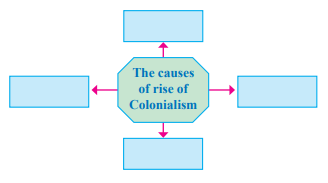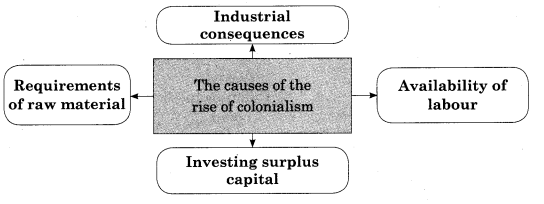European Colonialism – Solutions
Exercise
Q.1 (A) Choose the correct alternative and rewrite the statement.
1. ‘Declaration of Independence’ was drafted by.
(b) Thomas Jefferson
Rewritten Statement: The ‘Declaration of Independence’ was drafted by Thomas Jefferson.
2. The Second Anglo-Burmese War was fought during the times of.
(c) Lord Dalhousie
Rewritten Statement: The Second Anglo-Burmese War was fought during the times of Lord Dalhousie.
Q.1 (B) Find the incorrect pair from group ‘B’, and write the corrected one.
| Group ‘A’ | Group ‘B’ |
|---|---|
| Togoland | German colony |
| Egypt | British colony |
| Orange Free State | Dutch colony |
| Ivory Coast | Portuguese colony |
Answer:
Incorrect Pair: Ivory Coast – Portuguese colony
Corrected Pair: Ivory Coast – French colony
Explanation: The document states that Ivory Coast became a French colony in 1883, not a Portuguese colony.
Q.2 (A) Write the names of historical places/persons/events.
1. The region from Florida to California on the southern coast of America was under the control of –
Spain
Explanation: The document mentions that the coastal region from Florida to California was held by the Spanish.
2. The sea voyages for exploration were encouraged in the reign of Queen –
Elizabeth I
Explanation: The document notes that during the reign of Elizabeth I, explorers were encouraged to undertake marine expeditions.
Q.2 (B) Choose a correct reason and complete the sentence.
1. The British wanted to gain control over Myanmar, because ….
Answer:
(b) it was very important for them to control the natural resources and the market in Myanmar.
Completed Sentence: The British wanted to gain control over Myanmar, because it was very important for them to control the natural resources and the market in Myanmar.
Explanation: The document highlights that the British aimed to control Myanmar due to its rich natural wealth and potential as a market.
Q.3 Complete the concept map.
Answer:
Q.4 Write short Notes.
1. Nature of Colonialism
Colonialism is a form of imperialism where a developed nation occupies and rules a less developed, distant nation. It involves exploiting the colony’s resources by transporting raw materials to the colonizing country and using the colony as a market for finished products. Colonialism leads to political, economic, and psychological slavery, fostering an inferiority complex among native populations due to racial attitudes of the colonizers. The British Empire, for example, spanned Asia, Africa, America, and Australia, showcasing the global extent of colonial dominance.
2. American War of Independence
The American War of Independence (1775–1783) was a revolt by thirteen American colonies against British rule. Triggered by restrictive laws like the Stamp Act (1765) and the tea monopoly granted to the East India Company, the colonies resisted through events like the Boston Tea Party (1773). The First Continental Congress (1774) boycotted British goods, and the Second Continental Congress (1776) adopted the Declaration of Independence, drafted by Thomas Jefferson, asserting natural rights to life, liberty, and the pursuit of happiness. Key victories, such as at Saratoga, and support from France and Spain led to British surrender at Yorktown in 1781, securing American independence.
Q.5 Explain the following statements with reason.
1. The Industrial Revolution gave a momentum to colonialism.
The Industrial Revolution significantly boosted colonialism by increasing production through new machinery, creating surplus goods that required new markets. European nations needed dependable and easily dominated marketplaces to sell these products, as local consumption was insufficient. Additionally, the demand for cheap raw materials to sustain low production costs and the availability of surplus capital for investment in less developed regions drove European nations to establish colonies in Asia and Africa. These colonies provided both raw materials and markets, fueling colonial expansion.
2. European nations established colonies in America.
European nations established colonies in America to exploit its vast resources and strategic opportunities. The discovery of gold and silver mines in regions like Peru, Mexico, and Venezuela attracted Spain and Portugal, who seized lands and enslaved native populations for mining and agriculture. England, France, and Holland followed, seeking commercial benefits and new territories for settlement. The favorable climate and land in America allowed Europeans to displace indigenous people, establish settlements like Jamestown, and impose governance systems to control trade and resources, thereby expanding their global influence.



Leave a Reply